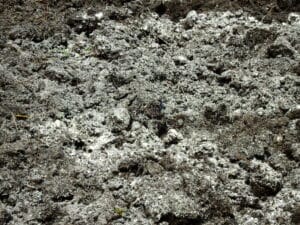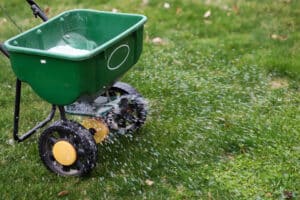To keep your lawn weed-free, incorporating pre-emergent herbicides in your lawn care routine is a smart strategy. These products target pesky weeds like crabgrass and dandelions before they sprout, giving your grass a healthier start. But timing is everything. Applying pre-emergent at the wrong time can render it useless or even harm your lawn. In this guide, we’ll dive into the ins and outs of pre-emergent application, covering when, how, and why.
Our team also reviewed the top lawn care service providers to help you choose the right company for your needs.
Find Lawn Help
- See our list of top lawn care companies based on in-depth research.
- Select the company that best meets your needs.
- Get a free, no-obligation quote for your home.
Get a Quote From Lawn Professionals Near You
Compare quotes from local pros

Lime Soil Amendment

Lawn Fertilization
What Is Pre-Emergent Herbicide?
A pre-emergent herbicide is a synthetic chemical application that prevents weeds from sprouting in your healthy lawn or flower bed. While this treatment doesn’t interfere with the weed’s seed germination, it does stop growth by stunting the formation of new roots.
Types of Pre-Emergent Herbicides
Pre-emergent herbicide typically comes in two different forms: liquid pre-emergent and granule pre-emergent. While each type kills sprouting weeds, they each have unique characteristics and application methods.
Liquid Pre-Emergents
Liquid pre-emergents are usually sold in pump-type sprayers or hose connections. One benefit of this type is its ease of application, as its fast flow rate allows it to evenly coat your lawn. While many lawn care experts prefer liquid pre-emergents, there are a few benefits to a granular treatment.
Granular Pre-Emergents
Granular pre-emergents require little to no mixing compared to their liquid counterpart, which makes preparation a little easier. Additionally, if you already own a lawn spreader for fertilizing, you can use it to apply granular pre-emergent.
How Does Pre-Emergent Herbicide Work?
Pre-emergent herbicides work by creating a makeshift barrier between germinated weeds and your lawn. This protective layer prevents weeds from breaching the topsoil, eliminating them before they can sprout. In addition to preventing existing weeds from growing, pre-emergent also reduces the chances of future problems by reducing the weed’s seed production.
When Should You Apply Pre-Emergent Herbicide?
The right time to apply your pre-emergent herbicide varies depending on the type of weeds in your lawn. For example, some weeds emerge in the fall while others, such as dandelions, grow in the early spring. You should also time pre-emergent application based on the climate where you live.
Spring Application
Spring applications help prevent the growth of spring and summer weeds, such as crabgrass and foxtail. For early spring weeds, wait until soil temperatures have been at least 55°F for at least 48 hours. Usually, this means an air temperature of 65–70°F. Often, this means homeowners in the southern U.S. can apply these herbicides much earlier in the year than northern homeowners. Those in particularly hot climates may need to start applying as early as mid-February.
However, it’s important to hold off on applying until your summer fruits and vegetables have sprouted, as pre-emergent can harm ungerminated plants. Additionally, some types of weeds sprout in the summer, so you may need to apply a different pre-emergent right before the heat sets in.
Quick Tip
- You should also schedule the timing carefully with regard to any other treatments you plan to apply to your lawn. For example, if you plan to aerate or dethatch your lawn, wait to apply herbicides until you’ve finished. Otherwise, you’d just remove the pre-emergent treatments you just applied. Never overseed after applying pre-emergent, since the herbicide will likely keep the grass from growing.
Fall Application
By the time cooler weather comes around, the protection from your spring pre-emergent has diminished. Fall applications keep new weeds from growing or surviving the winter, which is more important in southern climates where winters are milder. Apply this pre-emergent before soil temperatures reach 55 degrees for five or more days in a row. As with spring, plan around any other treatments you apply so they don’t work at cross purposes.
Common Mistakes To Avoid When Applying Pre-Emergent Herbicides
Applying pre-emergent herbicides can be tricky. Mistakes like applying them without consulting temperature and rainfall forecasts, failing to calibrate your spreader, and using herbicides in open outdoor spaces where children and pets play can hinder your turf care efforts. The sections below detail what to avoid when applying pre-emergent on your lawn.
Overwatering the Lawn
Overwatering is an easy mistake to make, especially if you’ve applied a granular herbicide. Use just enough water to dissolve the granules and activate the product, or follow the watering instructions provided on your herbicide’s label.
Timing Lawn Fertilization With Herbicide Application
Overlapping fertilization and pre-emergent treatments doesn’t benefit your plants. In fact, applying nutrients at the same time as a chemical herbicide can damage—and ultimately kill—your healthy turf. Allow two to four weeks between treatments to let the active ingredients fully absorb, then fertilize your lawn as usual.
Broadcasting Herbicide Onto Your Turf
Broadcasting or “blindly” spraying lawn chemicals may be easier than targeted application techniques, but it isn’t necessarily more effective. For best results, adhere to the manufacturer’s instructions on your herbicide’s product label.
Only Treating Bare Spots
Pre-emergent herbicides suppress future weed growth, but they don’t stop it altogether. To limit weed growth throughout the season, we recommend applying the product to the entire lawn or turf area rather than spot treating. This will ensure you have no (or very few) “bare spots” where weeds can take root.
Relying On One Product
Pre-emergence treatment is just one step in maintaining a healthy lawn. It doesn’t provide a permanent solution to turf problems such as compaction, soil dryness, poor drainage, or insufficient nutrients. You should pair your pre-emergent treatment with post-emergent herbicides for optimal control of summer weed growth.
Mowing Directly After Herbicide Application
You shouldn’t mow after pre-emergent treatments, but regularly cutting grass before applying doesn’t affect the results. Wait at least three to five days after treatment to cut the grass. This gives the product time to work into the soil and form that protective barrier against weed seeds (without being removed by aggressive lawn mowing).
What Is the Best Pre-Emergent Herbicide?
The right pre-emergent will depend on your yard and the type of weeds that grow. Here are some common active herbicide ingredients and the weeds that they target:
- Prodiamine: This chemical is typically used on crabgrass and dandelions. Herbicides that contain prodiamine can also be used to eliminate various broadleaf weeds and invasive grasses in your lawn.
- Oryzalin: Although this herbicide is usually administered in agricultural settings, some homeowners use it to eliminate yellow foxtail and intrusive vines, such as morning glory.
- Dithiopyr: This is used to stunt the growth of vining plants, broadleaf weeds, and invasive grasses. It can also inhibit turfgrass growth, so only use it on well-established, healthy lawns.
In addition to the type of weeds, it’s also important to consider the size of your lawn and the amount of effort you’re willing to put into treatment. For example, if you have a small area that you need to treat quickly, a granular pre-emergent may be a good option. However, if you’re looking for an even application across a large area and don’t mind a little pre-application mixing, a liquid pre-emergent could be the better choice.
Important Tips for Using Pre-Emergent Herbicide
Before applying pre-emergent weed control, consider the following application tips:
- Apply pre-emergent evenly: To completely protect your lawn from weeds, you’ll need to ensure no corner of your lawn is untouched.
- Don’t forget water: Herbicide applications are activated by water, which distributes chemicals throughout your lawn’s soil. To save water, you can apply pre-emergent before an expected rainfall. However, if rain isn’t in the forecast, be sure to water your lawn after application.
- Limit lawn activity: It’s important to ensure that the soil holding the pre-emergent is undisturbed after application. As such, you shouldn’t aerate after application, and you should hold off on mowing until after the pre-emergent has been watered.
- Maintain your lawn: Maintaining a healthy lawn can help the turfgrass naturally compete with common weeds. Routine maintenance should include mowing, proper irrigation, and pest control. If you don’t have time to fertilize or apply herbicide, consider hiring a top-tier lawn care service, such as TruGreen or Weed Man.
Our Conclusion
Pre-emergent herbicides give your lawn a strong head start by stopping weeds before they take hold. When you apply these products at the right time and use proper techniques, you create a healthier environment for your grass to thrive. Timing, application method, and product choice all play a role in how effectively you block weed growth throughout the season.
To keep your lawn in top shape, follow up pre-emergent treatments with good mowing habits, smart watering practices, and regular soil care. Avoid common mistakes by reading product labels carefully and adjusting your lawn care routine based on weather conditions and seasonal needs. With a little planning and attention, you can stay ahead of weeds and enjoy a lush, well-maintained yard year-round.
FAQs About Applying Pre-Emergent Herbicides
Is a pre-emergent an herbicide?
Yes. Herbicides are chemicals that kill weeds and other unwanted plants to protect surrounding vegetation. Unlike post-emergent herbicides, pre-emergents stunt the growth of weeds before they sprout.
What happens if I apply a pre-emergent too late?
If you apply a pre-emergent after the weeds have already germinated, it will be ineffective in preventing weed growth during the spring or summer. Pre-emergent will only work when applied before weeds take root.
Can I apply a pre-emergent in my flower bed?
Yes. Pre-emergents can be applied on lawns and garden flower beds to prevent weeds from growing and damaging healthy grasses, flowers, and vegetable gardens. Only apply pre-emergents after any flowers or plants have started to grow to prevent the chemicals from killing ungerminated seeds.





